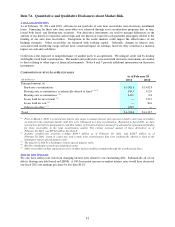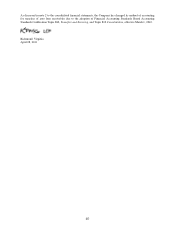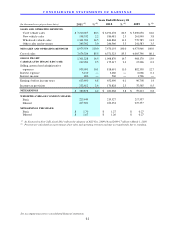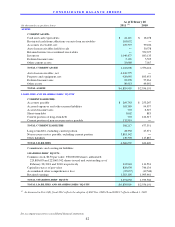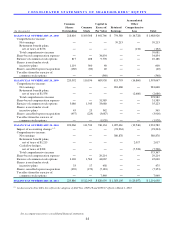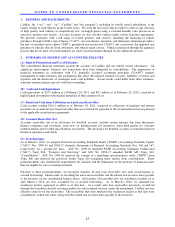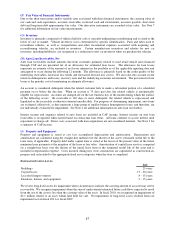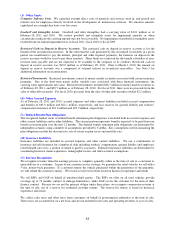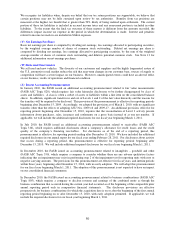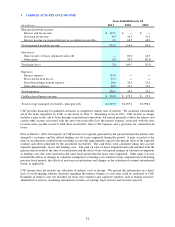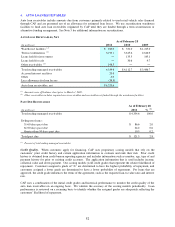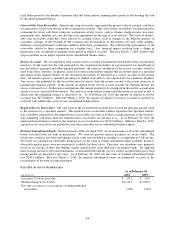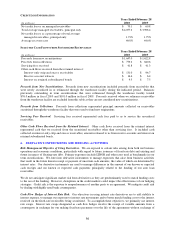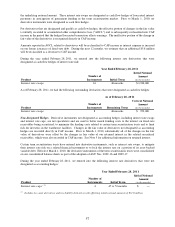CarMax 2011 Annual Report Download - page 57
Download and view the complete annual report
Please find page 57 of the 2011 CarMax annual report below. You can navigate through the pages in the report by either clicking on the pages listed below, or by using the keyword search tool below to find specific information within the annual report.
47
(F) Fair Value of Financial Instruments
Due to the short-term nature and/or variable rates associated with these financial instruments, the carrying value of
our cash and cash equivalents, accounts receivable, restricted cash and investments, accounts payable, short-term
debt and long-term debt approximates fair value. Our derivative instruments are recorded at fair value. See Note 7
for additional information on fair value measurements.
(G) Inventory
Inventory is primarily comprised of vehicles held for sale or currently undergoing reconditioning and is stated at the
lower of cost or market. Vehicle inventory cost is determined by specific identification. Parts and labor used to
recondition vehicles, as well as transportation and other incremental expenses associated with acquiring and
reconditioning vehicles, are included in inventory. Certain manufacturer incentives and rebates for new car
inventory, including holdbacks, are recognized as a reduction to new car inventory when we purchase the vehicles.
(H) Auto Loan Receivables, Net
Auto loan receivables include amounts due from customers primarily related to used retail vehicle sales financed
through CAF and are presented net of an allowance for estimated loan losses. The allowance for loan losses
represents an estimate of the amount of net losses inherent in the portfolio as of the applicable reporting date and
anticipated to occur during the following 12 months. The allowance is primarily based on the credit quality of the
underlying receivables, historical loss trends and forecasted forward loss curves. We also take into account recent
trends in delinquencies and losses, recovery rates and the underlying economic environment. The provision for loan
losses is the periodic cost of maintaining an adequate allowance.
An account is considered delinquent when the related customer fails to make a substantial portion of a scheduled
payment on or before the due date. When an account is 75 days past due, the related vehicle is automatically
eligible for repossession. Accounts are charged-off on the last business day of the month during which the earliest
of the following occurs: the receivable is 120 days or more delinquent, the related vehicle is repossessed and
liquidated or the receivable is otherwise deemed uncollectible. For purposes of determining impairment, auto loans
are evaluated collectively, as they represent a large group of smaller-balance homogeneous loans, and therefore, are
not individually evaluated for impairment. See Note 4 for additional information on auto loan receivables.
Interest income and expenses related to auto loans are included in CAF income. Interest income on auto loan
receivables is recognized when earned based on contractual loan terms. All loans continue to accrue interest until
repayment or charge-off. Direct costs associated with loan originations are not considered material. See Note 3 for
a summary of CAF income.
(I) Property and Equipment
Property and equipment is stated at cost less accumulated depreciation and amortization. Depreciation and
amortization are calculated using the straight-line method over the shorter of the asset's estimated useful life or the
lease term, if applicable. Property held under capital lease is stated at the lesser of the present value of the future
minimum lease payments at the inception of the lease or fair value. Amortization of capital lease assets is computed
on a straight-line basis over the shorter of the initial lease term or the estimated useful life of the asset and is
included in depreciation expense. Costs incurred during new store construction are capitalized as construction-in-
progress and reclassified to the appropriate fixed asset categories when the store is completed.
ESTIMATED USEFUL LIVES
Buildings
Capital leases
Leasehold improvements
Furniture, fixtures and equipment
Life
25 years
3 – 15 years
8 – 15 years
15 – 20 years
We review long-lived assets for impairment when circumstances indicate the carrying amount of an asset may not be
recoverable. We recognize impairment when the sum of undiscounted estimated future cash flows expected to result
from the use of the asset is less than the carrying value of the asset. In fiscal 2010, we recognized an impairment of
$2.1 million related to an asset within land held for sale. No impairment of long-lived assets resulted from our
impairment tests in fiscal 2011 or fiscal 2009.


